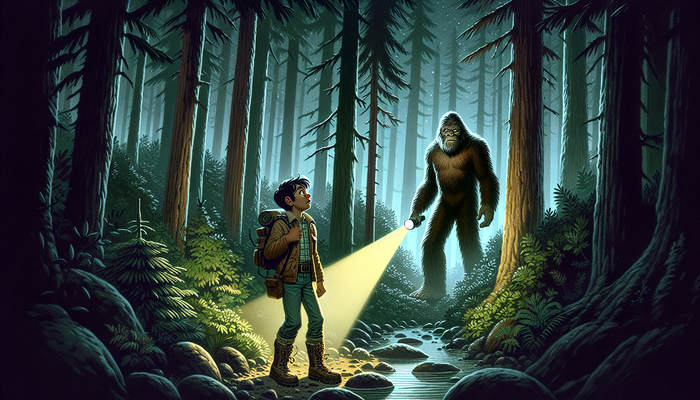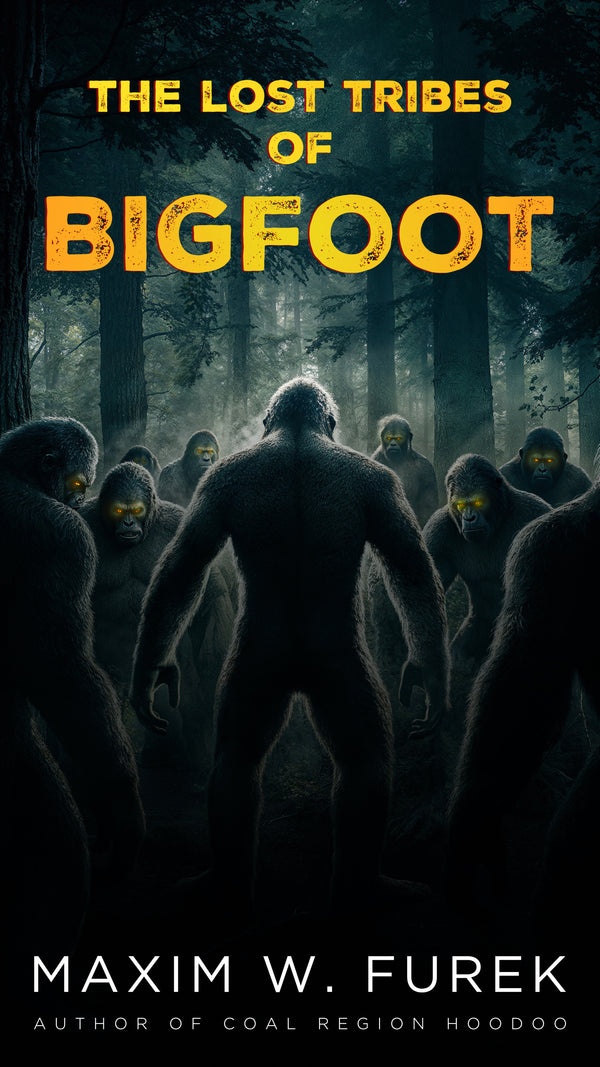Iowa's Bigfoot Sightings

By James Roberts, Cryptozoologist
The sun is just beginning to peek through the trees, casting an eerie glow across the landscape. Suddenly, a rustling in the underbrush catches your attention. You freeze, your heart pounding in your chest as you strain to see what's lurking in the shadows. Could it be a deer, a bear, or something else entirely?
This is the world of Bigfoot, a creature that has captured the imaginations of people around the globe for centuries. From the dense forests of the Pacific Northwest to the remote mountains of the Himalayas, tales of giant, hairy, humanoid beasts have permeated folklore and legend. But what if I told you that one of the most active hotspots for Bigfoot sightings isn't in some far-flung corner of the world, but right here in the heartland of America?
That's right, folks. The great state of Iowa, known for its rolling cornfields, friendly folks, and delicious pork tenderloin sandwiches, is also a veritable treasure trove of strange sightings. Over the past several decades, the Hawkeye State has been the site of dozens of credible eyewitness accounts, mysterious footprints, and strange vocalizations that have left even the most skeptical observers scratching their heads.
As a seasoned cryptozoologist and Bigfoot researcher, I've spent years traversing the rugged terrain of Iowa, interviewing witnesses, and piecing together the puzzle of this elusive creature. And let me tell you, the more I dig, the more fascinating and complex the story becomes.
In this article, we'll embark on a journey through the rich history of Iowa's Bigfoot sightings, exploring the patterns, theories, and mysteries that have emerged over the years. We'll examine some of the most notable encounters, from the infamous Ottosen sightings of the 1970s to the recent viral photographs from White Water Canyon. We'll delve into the potential connections to Native American folklore, the role of Iowa's unique landscape in the Bigfoot phenomenon, and the ongoing efforts to uncover the truth behind these enigmatic beasts.
So grab your hiking boots, pack a snack, and join me on this wild ride through the world of Iowa's Bigfoot. Whether you're a true believer or a die-hard skeptic, I guarantee you'll come away with a newfound appreciation for the mysteries that lurk in the shadows of America's heartland.
The Scope of Iowa's Bigfoot Phenomenon
When most people think of Bigfoot, their minds likely conjure up images of the dense, misty forests of the Pacific Northwest or the rugged mountains of the Rockies. But what if I told you that one of the most active hotspots for Sasquatch sightings is smack dab in the middle of America's heartland?
That's right, folks. The great state of Iowa, known more for its endless cornfields and friendly Midwestern charm than its cryptozoological wonders, has been a veritable hotbed of Bigfoot activity for decades. Don't believe me? Just take a look at the numbers.
According to the Bigfoot Field Researchers Organization (BFRO), one of the leading groups dedicated to investigating and documenting Sasquatch sightings, Iowa has racked up an impressive 76 documented encounters since the 1970s. That puts the Hawkeye State among the top contenders for Bigfoot sightings in the entire country, rubbing shoulders with the likes of Washington, California, and Oregon.
But it's not just the sheer volume of sightings that makes Iowa's Bigfoot phenomenon so intriguing. It's the way these encounters are distributed across the state that really raises some eyebrows. You see, Bigfoot sightings in Iowa aren't just confined to one or two isolated pockets. Oh no, these reports come from all corners of the state, from the rolling hills of the east to the wide-open prairies of the west.
However, when you start to look closer at the data, some interesting patterns begin to emerge. It turns out that certain counties in Iowa seem to be particularly prone to Bigfoot shenanigans. Take Dubuque County, for example. Nestled along the Mississippi River in the northeast corner of the state, this picturesque region has been the site of no fewer than six reported Bigfoot encounters. That's more than most entire states can boast!
But Dubuque isn't the only county getting in on the action. Head a little further west and you'll find Dallas County, home to another six Bigfoot sightings. And if you really want to up your odds of spotting a Sasquatch, you might want to plan a trip to Humboldt County, where a whopping nine encounters have been reported over the years.
Now, I know what you might be thinking. "James, this is all just a bunch of coincidences and tall tales. There's no way there's actually a pattern to these sightings." And hey, I get it. Skepticism is healthy, and it's important to approach any extraordinary claim with a critical eye. But when you start to look at the geographic distribution of these encounters, some intriguing possibilities begin to emerge.
Could it be that these clusters of sightings represent Bigfoot territories or migration routes? Are these areas particularly conducive to Sasquatch habitation, with the right mix of food, water, and shelter to support a population of elusive, hairy hominids? Or is there something else entirely at play here, some factor we haven't even considered yet?
These are the kinds of questions that keep me up at night, poring over maps and sighting reports, trying to piece together the puzzle of Iowa's Bigfoot phenomenon. And while we may not have all the answers yet, one thing is clear: the Hawkeye State is a hotspot for Sasquatch activity, and it's high time we start paying attention to what's going on in America's heartland.
Notable Iowa Bigfoot Encounters
When it comes to Bigfoot sightings, Iowa has no shortage of fascinating and perplexing encounters. From the rolling hills of the east to the wide-open prairies of the west, the Hawkeye State has been the site of some of the most intriguing Sasquatch activity in the country. Let's take a closer look at a few of the most notable cases.
The Ottosen Sightings of 1978
First up, we have the infamous Ottosen sightings of 1978. This series of encounters, which took place in the small town of Ottosen in north-central Iowa, involved multiple witnesses, including several children, who claimed to have seen a "short, hairy, ape-like animal with fangs and deep-set eyes" lurking in the shadows. The creature was described as being around five feet tall, with a stocky build and a foul odor that lingered long after it had vanished into the night.
As word of the sightings spread, the town of Ottosen was thrown into a frenzy. Media outlets from across the country descended on the small community, eager to get a piece of the Bigfoot action. Local residents banded together to search for the creature, combing the woods and fields for any sign of the elusive beast. But despite their best efforts, the Ottosen Bigfoot remained a mystery, vanishing into the mists of legend as quickly as it had appeared.
The Lockridge Monster of 1975
But the Ottosen sightings were just the beginning. Fast forward a few years to 1975, and we find ourselves in the tiny town of Lockridge, nestled in the rolling hills of Jefferson County. It was here that a hunter stumbled upon a grisly scene: the partially devoured carcasses of several turkeys, surrounded by a set of massive, mysterious tracks. The discovery set off a wave of sightings in the area, with locals reporting encounters with a "hairy, bear-like animal with a monkey face" that seemed to have a taste for poultry.
The Lockridge Monster, as it came to be known, quickly became the talk of the town. Farmers and residents alike claimed to have seen the creature lurking in the shadows, its glowing eyes peering out from the darkness. But despite the mounting evidence, local authorities remained skeptical, dismissing the sightings as the product of overactive imaginations and too much time spent in the woods.
But the physical evidence was hard to ignore. The turkey carcasses, the massive footprints, the consistent descriptions of the creature's appearance - it all pointed to something strange and unexplained stalking the hills of Jefferson County. To this day, the Lockridge Monster remains one of the most compelling cases of Bigfoot activity in Iowa's history.
The White Water Canyon Photographs of 2021
Fast forward to 2021, and we find ourselves in the midst of a new wave of Bigfoot fever, thanks to a series of viral photographs captured near the town of Bernard in eastern Iowa. The images, which were taken by a local man named Jeremy and his sister while on a morning walk in White Water Canyon, show a large, ape-like figure lurking in the shadows of the forest.
The photographs quickly spread like wildfire across social media, sparking a renewed interest in Iowa's Bigfoot phenomenon. Cryptozoology enthusiasts and skeptics alike pored over the images, debating their authenticity and speculating about what they might represent. Some claimed the figure was clearly a Sasquatch, while others dismissed it as a hoax or a case of misidentification.
But regardless of where you stand on the White Water Canyon photographs, there's no denying that they've reignited the conversation about Bigfoot in Iowa. And they're far from the only recent example of Sasquatch activity in the state.
The Yellow River State Forest Episode of "Finding Bigfoot"
In 2019, the popular Animal Planet series "Finding Bigfoot" devoted an entire episode to investigating sightings in the Yellow River State Forest in northeastern Iowa. The show's team, led by renowned Bigfoot researcher Matt Moneymaker, spent several days trekking through the rugged terrain of Allamakee County, interviewing witnesses and searching for signs of Sasquatch activity.
And boy, did they find them. The team claimed to have heard strange vocalizations echoing through the forest at night, and even captured what they believed to be a glimpse of a large, hairy figure moving through the underbrush. While the evidence was far from conclusive, it was enough to convince Moneymaker and his colleagues that something strange was afoot in the Yellow River State Forest.
Of course, not everyone is convinced by these high-profile cases. Skeptics argue that eyewitness accounts are notoriously unreliable, and that even the most compelling photographs and recordings can be easily hoaxed or misinterpreted. And they're not entirely wrong - the history of Bigfoot research is littered with frauds, hoaxes, and cases of mistaken identity.
But for those of us who have spent years studying the Bigfoot phenomenon, there's something about these Iowa cases that just feels different. The consistency of the descriptions, the geographic clustering of the sightings, the sheer volume of reports - it all points to something more than just a bunch of tall tales and overactive imaginations.
And so we press on, sifting through the evidence, interviewing witnesses, and traipsing through the woods in search of answers. Because whether you're a true believer or a die-hard skeptic, there's no denying the allure of the unknown, the thrill of the hunt, and the tantalizing possibility that maybe, just maybe, there's something out there in the shadows of Iowa's forests, waiting to be discovered.
Connections to Native American Folklore
As we delve deeper into the mysteries of Iowa's Bigfoot sightings, it's important to recognize that these encounters don't exist in a vacuum. In fact, the idea of giant, hairy, humanoid creatures roaming the wilderness has deep roots in the folklore and mythology of many Native American cultures, including those that once called Iowa home.
The Sts'ailes Legend of Sasq'ets
One of the most intriguing connections can be found in the legends of the Sts'ailes people, a First Nations group from the Fraser Valley region of British Columbia. The Sts'ailes have long told stories of a creature known as Sasq'ets, a benevolent forest guardian who is said to protect the land and its inhabitants from harm. Sasq'ets is described as a large, hairy, human-like being with a gentle demeanor and a deep connection to the natural world.
Sound familiar? It should, because the description of Sasq'ets bears a striking resemblance to many modern accounts of Bigfoot. From the towering stature to the thick, shaggy fur, the parallels between Sasq'ets and Sasquatch are hard to ignore. And while the Sts'ailes people may be geographically distant from Iowa, their legends serve as a reminder that the idea of Bigfoot-like creatures has deep roots in indigenous cultures across North America.
The Lummi Legends of Bigfoot-like Creatures
But the Sts'ailes aren't the only Native American group with stories of giant, hairy humanoids. The Lummi people, who traditionally inhabited the coastal regions of Washington state, have their own legends of Bigfoot-like creatures that are said to roam the forests and mountains of the Pacific Northwest. These beings are often described as towering, shaggy-haired giants with a fierce and sometimes violent disposition, a far cry from the gentle Sasq'ets of Sts'ailes lore.
Implications for Iowa's Bigfoot Sightings
So what do these Native American legends have to do with Iowa's Bigfoot sightings? Well, for one thing, they provide a fascinating historical context for the idea of giant, humanoid creatures living in the wilderness of North America. These stories suggest that the concept of Bigfoot is not a modern invention, but rather a deeply ingrained part of indigenous folklore that has been passed down through generations.
But there's another, more intriguing possibility to consider. What if the Native American legends of Sasq'ets, the Lummi giants, and other Bigfoot-like creatures are actually based on real encounters with these elusive beasts? What if these stories are not just myths and legends, but rather oral histories that preserve the memory of ancient sightings and interactions with Sasquatch-like beings?
It's a tantalizing idea, and one that has captured the imaginations of Bigfoot researchers and enthusiasts for decades. After all, if Bigfoot is real, it stands to reason that indigenous peoples, with their deep connection to the land and their keen observational skills, would have been among the first to encounter these creatures and incorporate them into their cultural traditions.
Of course, we have to be careful not to read too much into these Native American legends. Folklore and mythology are complex and multifaceted, and it's important not to oversimplify or appropriate these stories for our own purposes. But at the same time, we can't ignore the striking parallels between these ancient tales and modern Bigfoot sightings, particularly in a place like Iowa where the history of indigenous cultures runs deep.
So as we continue to investigate the mysteries of Iowa's Bigfoot phenomenon, let's keep an open mind and an eye towards the past. Who knows what secrets and insights these ancient legends may hold, and how they might help us unravel the enigma of Sasquatch once and for all?
From Bigfoot to UFOs: Hangar 1 Publishing Has You Covered!
Explore Untold Stories: Venture into the world of UFOs, cryptids, Bigfoot, and beyond. Every story is a journey into the extraordinary.
Immersive Book Technology: Experience real videos, sights, and sounds within our books. Its not just reading; its an adventure.



























